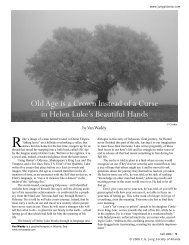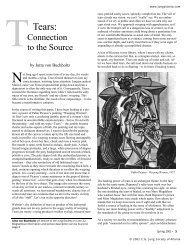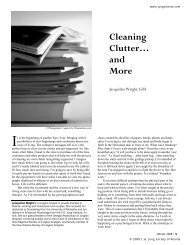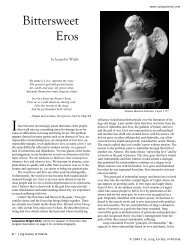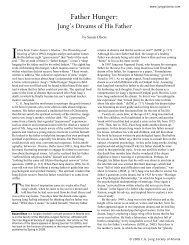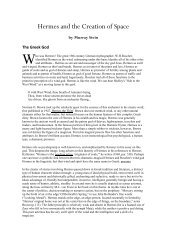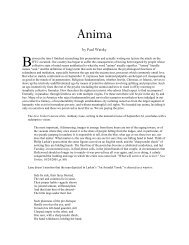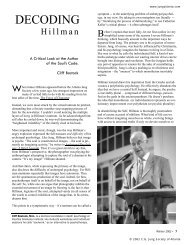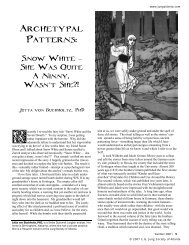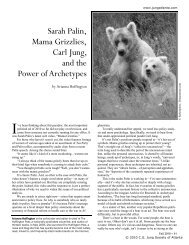My Break with Jung - Virginia Apperson - C.G. Jung Society of Atlanta
My Break with Jung - Virginia Apperson - C.G. Jung Society of Atlanta
My Break with Jung - Virginia Apperson - C.G. Jung Society of Atlanta
You also want an ePaper? Increase the reach of your titles
YUMPU automatically turns print PDFs into web optimized ePapers that Google loves.
tions. Furthermore, their romance paralleled <strong>Jung</strong>’s affairs <strong>with</strong><br />
Sabina Spielrein (the subject <strong>of</strong> the recent film, A Dangerous<br />
Method) and Toni Wolff. Apparently all three women shared<br />
similar temperaments and “led [<strong>Jung</strong>] into unfathomed reaches”<br />
(p. 158).<br />
Frankly, I was horrified after reading Translate this Darkness.<br />
Learning <strong>of</strong> <strong>Jung</strong>’s subjugating response to Morgan disturbed<br />
me enough to question whether I wanted to continue my<br />
training, and I considered heading home, sans diploma. In spite<br />
<strong>of</strong> this dis-ease, I took my final exams and then used my thesis<br />
as a way to wrestle <strong>with</strong> the knowledge <strong>of</strong> <strong>Jung</strong>’s egregious<br />
advice to Morgan to sacrifice her individuation in service <strong>of</strong><br />
Murray’s pursuits. Prominent among the <strong>Jung</strong>ian authors that<br />
had resonated <strong>with</strong> me were women such as Marie Louise von<br />
Franz, Sylvia Brinton Perera, Linda Leonard, Marion Woodman,<br />
Clarissa Pinkola Estes, Ann Ulanov, to name a very few.<br />
Their insights, that advanced <strong>Jung</strong>’s ideas around feminine<br />
development in both women and men, helped me enormously<br />
in my own personal development, as well as work <strong>with</strong> my<br />
analysands. Before completing my training, I had to reconcile<br />
the discovery <strong>of</strong> <strong>Jung</strong>’s interference in Morgan’s individuation<br />
that seemed completely at odds <strong>with</strong> what had become most<br />
precious and fundamental in my understanding <strong>of</strong> <strong>Jung</strong>ian<br />
Psychology.<br />
Claire Douglas grappled <strong>with</strong> a related paradox as she tells<br />
a tale as old as time <strong>of</strong> a scintillating woman sidelined and<br />
obscured by the men in her life: men that claimed to admire and<br />
adore her, as long as she served their narcissistic need to project<br />
their feminine potential onto her, rather than recognize such an<br />
animating experience as an opportunity to connect <strong>with</strong> their<br />
own feminine potential. Douglas puts Morgan’s tragedy into<br />
perspective in her description <strong>of</strong> some <strong>of</strong> the most impressive<br />
women in <strong>Jung</strong>’s (and Freud’s) circle that had a:<br />
Beguiling combination <strong>of</strong> vibrancy, charm, quick intuitive<br />
thinking, a deep interest in the world <strong>of</strong> ideas, and a<br />
capacity for exciting and inspiring the men in their<br />
lives. These women tended to manifest a problematical<br />
creativity <strong>of</strong> their own, which penetrated the unconscious<br />
and explored its realms to a depth that fascinated<br />
both Freud and <strong>Jung</strong>. The women were able to form<br />
bridges between their own creative energies and the<br />
creativity at times latent in their analysts. However,<br />
instead <strong>of</strong> cultivating this creativity for their own benefit,<br />
the women were encouraged to project it onto a<br />
series <strong>of</strong> numinous men and to subordinate their own<br />
talents in order to advance the men’s work. Each<br />
poured her talents and energy into the career <strong>of</strong> a male<br />
analyst who took her as a companion. Recently some <strong>of</strong><br />
these women – Lou Andreas-Salome, Anais Nin, Ruth<br />
Mack Brunswick, Beata (Tola) Rank, Toni Wolff,<br />
Sabina Spielrein, and Christiana Morgan – have found a<br />
degree <strong>of</strong> recognition, but all lack a comprehensive and<br />
empathic analysis <strong>of</strong> their struggle as creative women at<br />
the center <strong>of</strong> their own stories. (pp. 12-13).<br />
ouglas generates such an analysis <strong>of</strong> Christiana Morgan’s<br />
D life in her well-documented book. In a similar vain,<br />
though not as responsibly documented, David Cronenberg<br />
brings Sabina Spielrein’s story to an even larger audience <strong>with</strong><br />
his film, A Dangerous Method.<br />
www.jungatlanta.com<br />
As I revisit my initial reading <strong>of</strong> Translate this Darkness<br />
and my subsequent falling out <strong>with</strong> <strong>Jung</strong>, I remember how<br />
important this disillusionment was, challenging me to consider<br />
what mattered most in <strong>Jung</strong>’s visionary theories. To hold the<br />
tension <strong>of</strong> opposites (one <strong>of</strong> <strong>Jung</strong>’s most fundamental concepts)<br />
between <strong>Jung</strong>ian theory and the realization that <strong>Jung</strong> (like all <strong>of</strong><br />
us!) was a flawed, complex-influenced person helped me<br />
through this confusing time. Writing my thesis, “Revising the<br />
Notion <strong>of</strong> Living Happily Ever After: Finding the Gleam in<br />
Your Own Eyes,” provided me the outlet for this wrestling<br />
match. And for weeks on end, I holed up in my tiny apartment<br />
working furiously and feverishly.<br />
As I tried to square the <strong>Jung</strong>ian theory I had come to value<br />
<strong>with</strong> <strong>Jung</strong>’s shortsightedness, I was aware <strong>of</strong> how easy it was to<br />
get stuck in my inflammatory reaction to <strong>Jung</strong>’s duplicity and<br />
lose sight <strong>of</strong> that which I found so life-giving. Similarly, I<br />
imagine many leave A Dangerous Method disgusted—<strong>with</strong><br />
vivid images <strong>of</strong> the sensationalized sadomasochistic sex scenes<br />
between <strong>Jung</strong> and Spielrein—forgetting the portrayal <strong>of</strong> the<br />
intensely curious and radically insightful <strong>Jung</strong>. In contrast,<br />
Douglas balances her exposure <strong>of</strong> <strong>Jung</strong>’s self-serving parochialism<br />
<strong>with</strong> his progressive approach that afforded Morgan an<br />
opportunity to plunge into the rich depths <strong>of</strong> her unconscious,<br />
resurfacing <strong>with</strong> brilliant experiences and images (p. 164). With<br />
her enviable facility for reverie, <strong>Jung</strong> enthusiastically supported<br />
her trances and active imaginations, enabling Morgan to bring<br />
her feeling function to life. From Morgan’s journals, she relates<br />
an evolving heroine’s tale that demanded a “conscious relation<br />
<strong>with</strong> her dark dragon,” rather than the typical hero quest in<br />
which the dragon must be slayed:<br />
Crucially, she did not make the dragon nice, or socially<br />
acceptable, nor did she kiss it in the hope she would be-<br />
Christiana Morgan - drawing for Thematic Apperception Test<br />
Winter 2012 • 5<br />
© 2012 C.G. <strong>Jung</strong> <strong>Society</strong> <strong>of</strong> <strong>Atlanta</strong>




